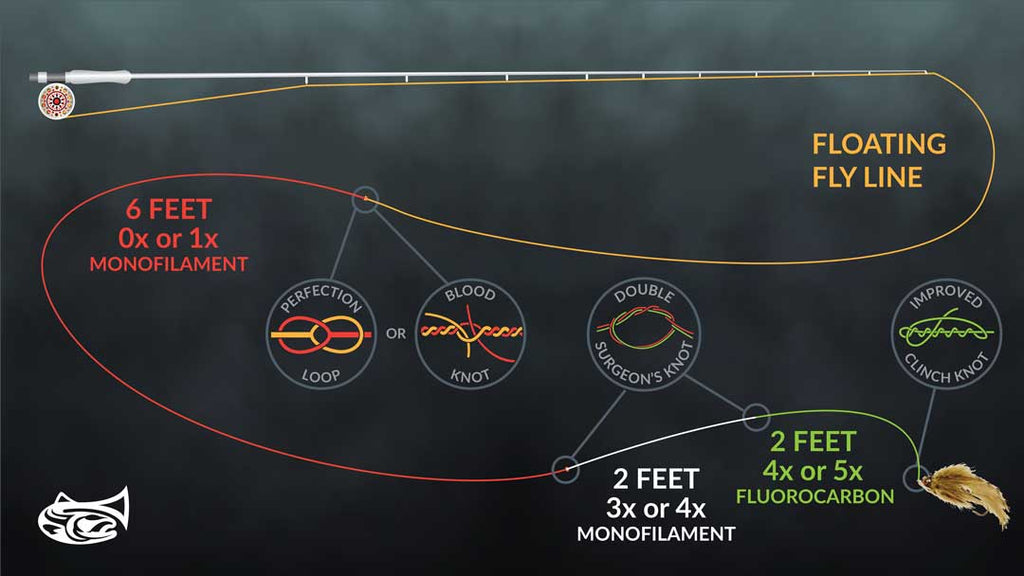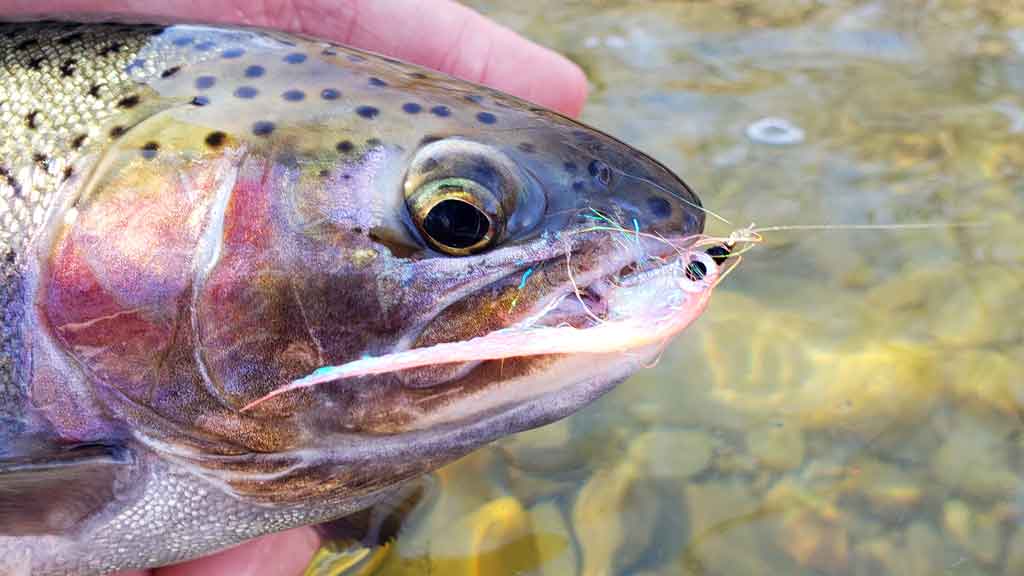When you are streamer fishing for trout, you need to ensure that your leader is the appropriate length to maximize your chance of success. Everyone appears to have their own ideas about the optimal trout streamer leader formula, but there are no hard and fast rules around it. This can mean that the beginner or newcomer fly fisher struggles to understand how to approach it.
A general rule when you are building a leader for streamers, what you are aiming for is the proper correlation between the three major parts of the leader: the butt section, the tapered section, and the tippet section.
A traditional formula for how to approach this is to aim for a 60/20/20 percentage ratio. In other words, the butt section will count for 60%, the tapered section will be 20%, and the tippet will also be 20%. This is the standard formula to start the build of a streamer leader.

When you are building a leader for streamers, what you are aiming for is the proper correlation between the three major parts of the leader: the butt section, the tapered section, and the tippet section.
It has been said that all other formulas are essentially just derivations on this basic 60/20/20 formula. While that might be oversimplifying things a little, there is certainly something to be said for that idea.

As it happens, it can be a relatively straightforward thing as long as you approach it right. In this post, we will take you through some of the best and most successful streamer leader formulas you might want to try out to catch more trout. Specifically, we'll look at fishing from the bank, from a riverboat, and on a lake.
Of course, if you want to know the exact best formula for trout fly fishing, you will need to consider a number of important factors. This includes the leader itself, the form of streamer you are using, and the kind of environment you are fishing in: whether you're working from the bank, you're in a boat on a river or lake fishing.
Read on, and we will look into all of this in detail, empowering you to know precisely how to choose the best streamer leader formula every time so that you can catch much more trout without fail.

The Best Streamer Leader Formulas To Catch More Trout
So let’s get into it. As we have seen already, the main thing to remember in all of this is that you are often working with a variation of the traditional 60/20/20. But it’s not entirely that simple, and there are some other things to bear in mind. When you get into shorter leaders sizes, you will most likely be using a 60/40 formula or even just a straight tippet setup. Let’s take a look at some of the best formulas out there that you might want to try out for yourself.
There are four streamer leader formulas that are successful when streamer fishing for trout.
#1. River Fishing From The Bank - Slow Currents
Suppose you are fishing from the bank and working with slow currents or in an area of shallow water becoming deeper. In that case, you might want to try out the following formula: roughly 4 feet of 3x or 4x Fluorocarbon tippet from the fly line to the fly. This works during that kind of transition spot because trout will often be looking up in this way, so they are more likely to catch the streamer with this approach. It's well worth trying next time you find yourself in that specific situation.

#2. River Fishing From the Bank - Medium Currents
Again if you are fishing from the bank, but you find the water is in moderate currents, you will want to change up the tippet length a little. This time, you will be looking at more length on the tippet, about 5 to 6 feet, compared to the 3 or 4 we saw above. First start with 4 feet of 3x Fluorocarbon or Monofilament. Then tie on an additional 2 feet of 5x Fluorocarbon for the tippet. This can prove to be especially useful with moderate currents or depth, and you might find that you also want to include a streamer weighted with lead eyes or a tungsten bead. In either case, this is the kind of length of tippet you want for medium currents and medium depths.

#3. River Fishing from a Boat - Floating & Full-Sink Lines
If you are fishing on a river and using full-sink lines, you might instead want to try out the following formula. In this formula, the total maximum length of the leader is only ever going to be around 4 feet. An excellent example of this formula at work would be approximately 24" of Ox or 1x braided Fluorocarbon or Monofilament for the butt, a triple surgeon's knot, and then 18"-24" of 5x or 6x Fluorocarbon.

If you are fishing on a river with a floating line, you'll be more likely to want a total leader length of between 7 and a half feet and 10 feet, so it's a little longer. That will likely include one to three feet of the Ox at the butt end, as needed, but that will, of course, depend on the situation at hand.
Floating and Sinking line should be picked depending on what type of streamer you are using. If you are using large unweighted streamers, a sinking line is recommended as it will get the fly into the feeding zone as soon as it hits the water.
If you have a weighted streamer, then you can get away with a floating line as the streamer will sink and then you can start your retrieve.
#4. Lake Fishing
The main thing to remember about lake fishing is that the water is often considerably clearer. That means you need more length, so it's not unheard of to have leaders up to 20ft long. For this example we want will be fishing a 11 foot deep lake and want our fly to be 1 foot from the bottom, so we will have a 10-12 feet of leader line in total here. That might seem a little extravagant, but it can help, and you will find that you are much more likely to catch those trout.
To learn more about fly fishing in lakes and still water check out our great article here>
As long as you get the length right on that front, you can apply the standard 60/20/20 rule, and you will probably find that this is sufficient for most kinds of lake fishing for trout. Remember that trout are not one of the more challenging fish to catch, so you should find that this is suitable in most cases. As long as you have got the right overall length, you should be fine.

How To Choose A Leader Thickness for Streamer Fly Fishing
You might also be wondering how you can choose a leader and what kinds of concerns might go into that decision-making process. This is probably simpler than you might think, but you do need to be aware of a few key things in particular if you are going to make the right choices here.

To choose a leader, consider the size of the streamer you will be working with, its weight and material, and its wind resistance. You probably don't want to go any smaller than about a 4x leader before you get to your tippet, and generally, a 3x is going to be optimal in most cases. But if you are fishing for saltwater, bass or carp, you might want to consider 2x or even 0x.
Making A Leader
If you are thinking about making your leader using the information we have already looked into here, there are many steps that you will need to follow. First up, get together all of the tools that will be required for the process. That includes a few varieties of the line you are using, probably made of fluorocarbon. You could also use nylon monofilament if preferred. You'll also need your spools of appropriate length.
For the butt section, you are going to need a stiffer material, either in .022, .025, or .017. The midsection requires a material that is slightly limper than the butt and should be around .015-.018 at most. Of course, it does depend. Finally, the tippet needs to be appropriate, as discussed above, but that could mean anything from 3x to 8x. You'll also need a tape measure and some scissors.

Next up is deciding on your leader formula and choosing your length and size. You can go for those listed above, or you can simply stick with the traditional and straightforward 60/20/20 formula. Then you need to cut all of the material to the correct length following your formula. Be sure not to mix up the different sections as you do this.
Once you have done that, you just need to tie each leader section together in the right sequence. That means: tying a perfection loop in one end of the butt material, tie the other end of the butt section to the middle with a three-turn blood knot. Then you connect the remainder of that section with four-turn blood knots or triple surgeons knot. Finally, with a five-turn blood knot or another triple surgouns knot, you need to tie the tippet to the last section of the middle, and you're done. Then it's just a case of packaging up your leader and keeping it safe until you need to use it.
All of that can be a little daunting and confusing, but as long as you work at it, you should find you can make it make sense in no time. Get that right, choose your formula, and you'll be amazed at how many more trout you can catch wherever you are fishing.

About the Author
Matthew Bernhardt, a third-generation Coloradan, grew up at the forefront of the state’s fly-fishing revolution, enjoying time on the water, side by side with experienced guides and lifelong anglers.
By combining his passion for fly-fishing with input from other experienced fly-fishers and guides and his fine arts degree from Colorado State University, Matthew spent five years carefully developing the Drifthook Fly Fishing System, built to help every angler catch more trout.
When he’s not spending time with his wonderful family, you’ll find him out on the water catching MONSTER trout, and he anxiously looks forward to the day when his kids are old enough to join him there.




1 comment
Matthew Hayes
I use the Kelly Galloup leader formula for streamer fishing, nothing works better.
I use the Kelly Galloup leader formula for streamer fishing, nothing works better.